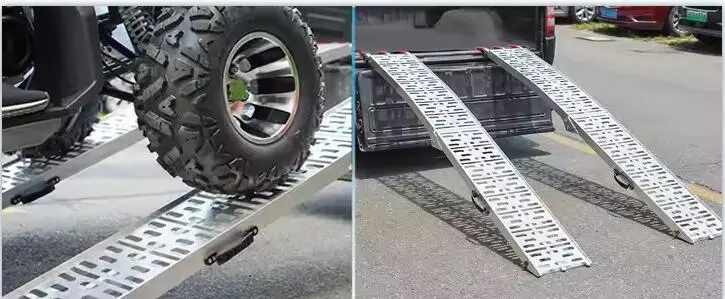Moto Ramp Safety Tips: How to Securely Load and Unload Your Motorcycle?
Loading and unloading your motorcycle safely is crucial for both your bike's protection and your personal safety. A quality moto ramp is essential for this process. To securely load your motorcycle, position the ramp at the correct angle, ensure it's firmly attached to your vehicle, and use tie-downs to stabilize your bike. When unloading, maintain a steady speed, keep the bike straight, and have a spotter assist you. Always wear protective gear, check your equipment before use, and practice in a safe environment to build confidence. By following these moto ramp safety tips, you'll master the art of safely transporting your beloved two-wheeler.

Essential Equipment for Safe Motorcycle Loading
Choosing the Right Motorcycle Ramp
Selecting an appropriate motorcycle ramp is the foundation of safe loading and unloading. Look for ramps made from durable materials like aircraft-grade aluminum, which offers strength without excessive weight. The ramp's width should accommodate your bike's tires comfortably, typically ranging from 7 to 12 inches. Consider the ramp's weight capacity, ensuring it can support your motorcycle with a safety margin. Foldable ramps are convenient for storage and transport, while arched designs provide better clearance for low-slung bikes.
Tie-Down Straps and Securing Devices
High-quality tie-down straps are indispensable for safely securing your motorcycle during transport. When loading your bike onto a trailer or truck bed using a moto ramp, opt for ratchet straps or cam buckle straps with a breaking strength well above your bike's weight. Soft-loop straps are ideal for attaching to handlebars without causing damage. Additionally, invest in a wheel chock to keep the front wheel stable and prevent the bike from rolling. Some riders prefer axle straps for added security, especially for heavier motorcycles or long-distance transport.
Safety Gear for the Rider
Personal protective equipment is crucial when loading and unloading your motorcycle. Wear a DOT-approved helmet to protect your head in case of a fall. Non-slip gloves provide better grip on handlebars and controls. Steel-toed boots offer protection for your feet and enhance traction on the ramp. Consider wearing knee and elbow pads for extra protection against scrapes and impacts. High-visibility clothing can also be beneficial, especially when loading in low-light conditions or near traffic.
Step-by-Step Guide to Loading Your Motorcycle
Preparing the Loading Area
Before attempting to load your motorcycle, ensure you're in a safe, level area away from traffic. Clear the loading zone of any debris or obstacles that could interfere with the process. If possible, position your vehicle on a flat, solid surface to provide a stable foundation for the ramp. Check the weather conditions; avoid loading in strong winds or on slippery surfaces if possible. If loading at night, set up adequate lighting to illuminate the entire loading area.
Proper Ramp Positioning and Securement
Position your motorcycle loading ramp at the correct angle - typically between 10 to 15 degrees. A steeper angle increases the risk of the bike tipping or losing traction. Securely attach the ramp to your vehicle using the provided safety straps or hooks. Double-check that the ramp is centered on the tailgate or bumper and that all attachment points are tight. Some riders place a non-slip mat under the ramp's base for added stability.
Guiding the Motorcycle Up the Ramp
Start by aligning your motorcycle with the center of the moto ramp. If you're walking the bike up, stand on the left side with the bike between you and the ramp. Engage the clutch and use the throttle to provide gentle power as you walk the bike up. Maintain a steady pace and keep the front wheel straight. If riding the bike up, use smooth, consistent throttle control and keep your body centered over the bike. Once the front wheel is in the truck bed or trailer, continue moving forward until the bike is fully loaded. Apply the brakes and engage the kickstand before dismounting.
Unloading Techniques and Safety Precautions
Preparing for Unloading
Before unloading, ensure your vehicle is parked on a level surface with the parking brake engaged. Recheck the ramp's attachment to your vehicle and clear the unloading area of any obstacles. Remove all tie-downs and securing devices from your motorcycle, but leave the wheel chock in place until you're ready to move the bike. If you have a spotter available, brief them on hand signals and safety procedures. Take a moment to visualize the unloading process and mentally prepare yourself for the task.
Controlled Descent Techniques
When unloading, the key is to maintain control throughout the descent. If walking the bike down, position yourself on the uphill side of the motorcycle. Use the clutch and rear brake to control your speed, letting gravity do most of the work. Keep the front wheel straight and resist the urge to use the front brake, which can cause the bike to pitch forward. If riding down, maintain a very low speed using engine braking and the rear brake. Keep your body weight centered or slightly back on the bike. As you transition from the motorcycle ramp to the ground, be prepared for a slight change in the bike's balance.
Post-Unloading Safety Checks
Once your motorcycle is safely on the ground, perform a quick safety check before riding. Inspect the tires for any damage that may have occurred during transport. Check that all controls, including the throttle, clutch, and brakes, are functioning correctly. Ensure that mirrors and turn signals are properly adjusted. If your bike has been secured for an extended period, allow the suspension to settle before riding. Finally, remove and store your loading ramp and any other equipment used during the unloading process.
Conclusion
Mastering the art of safely loading and unloading your motorcycle using a moto ramp is essential for every rider who transports their bike. By investing in quality equipment, following proper techniques, and prioritizing safety at every step, you can ensure that your motorcycle arrives at its destination in perfect condition. Remember, practice makes perfect - take the time to familiarize yourself with your specific motorcycle loading ramp and vehicle setup. With these safety tips and a cautious approach, you'll be able to confidently load and unload your motorcycle for many adventures to come.
Contact Us
For more information about high-quality moto ramps, work stands, and customized aluminum tool boxes that can enhance your motorcycle maintenance and transport experience, don't hesitate to reach out to us at info@runva.com.cn. Let us help you make your motorcycle journeys safer and more enjoyable!
References
Smith, J. (2022). The Complete Guide to Motorcycle Transport Safety. Rider's Digest Publications.
Johnson, A. & Brown, T. (2021). Motorcycle Loading Techniques: A Comprehensive Manual. Two-Wheel Transport Press.
Miller, R. (2023). Safety First: Motorcycle Ramp Selection and Usage. Biker's Handbook Series.
Thompson, L. (2022). The Physics of Motorcycle Loading and Unloading. Engineering for Riders Journal, 15(3), 78-92.
Garcia, M. & Lee, S. (2023). Preventing Injuries During Motorcycle Transport: A Study of Best Practices. Journal of Motorcycle Safety, 8(2), 112-126.
Wilson, K. (2021). DIY Motorcycle Maintenance: From Loading to Repair. Home Mechanic Publications.

_1737625693698.webp)

